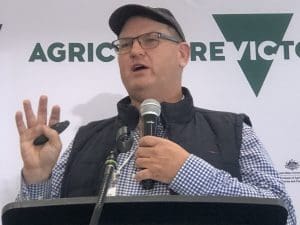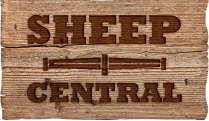
Consultant Jason Trompf at the Dunkeld workshop.
SHEEP producers were urged to focus on creating more animals over the next five years because national flock estimates over recent years have been overstated, consultant Jason Trompf has told a BestWool BestLamb Better Beef Roadshow workshop at Dunkeld.
As district farmers battled lack of rain and high feed costs to maintain flocks, Mr Trompf delivered a series of “slaps and sledges” on early lambing, commencing ewe feeding too late, benchmarking myths, ram selection and being adaptable to varying seasons.
Mr Trompf urged farmers to reconsider the practice of earlier lambing to allow time to finish lambs, rather than optimising ewe stocking rates and reproduction by matching feed and pasture supply curve by lambing later in spring.
“Over the next five years, just create more animals, don’t beat yourself up whether you can finish them.
“Just create more animals because we are only waking up, the industry is only waking up to what’s happened in the demise of our national flock – we aren’t very good at counting would be the most tactful way I can put it.”
“The system is busted and the main reason I’ll tell you it’s busted is that the marking rate (100 percent) that they are working on nationally to model the flock is I believe is out to the tune of about 10pc in the high direction,” he said.
“It has inflated the ewe flock number to a number that I don’t think reflects what was here 18 months ago – it was already too high.
“And you talk to the processors and they say ‘Trompfy you’re wrong mate, look at our kill numbers; we couldn’t have those kill numbers if that’s not the ewe base,” he said.
“And I say at least a third of your lamb kill has been sustained by female lambs that otherwise would have gone back into the flock.”
He said the industry had to come up with a better way of calculating the national flock number.
“Because the next five years just create more animals.
“Get your timings right, create more animals and sell them, because there is a lot of country that needs restocking.”
According to Meat & Livestock Australia, in 2026 the flock is forecast to ease by 1.8pc to 71.9 million head and lift by 3pc to 74.1
million head by 2027.
Mr Trompf suggested industry survey results could be biased by lower-performing producers being reluctant to participate, with respondents being mostly progressive higher performing farmers who have adopted more elements of best practice and achieved marking rates around 10 pc above the industry average.
Mr Trompf started positively stating that there were some things producers were doing well and others that needed to be revisited.
Feed early and efficiently
He cited ‘old mate Hanrahan’s’ unproductive complaints about the ruination coming from too much or too little rain and a 1960 manager’s drought report lamenting that no one started feeding their sheep on time, didn’t segregate fat and thin ewes, nor know their pregnancy status.
“And one of the rules that you all learnt, that the first commandment out of the top ten in Lifetime Ewe Management ….. is feed a little early than a lot late.
“The concept is that it costs 3kg of grain to maintain a kilo of bodyweight and 8 kilos if you let it lose it to put it back on,” he said.
“It is at least 2.5 times more efficient to feed a little early rather a lot late.”
Mr Trompf commended sheep producers for shifting their management and turning up to top up their knowledge “and make an even better decision tomorrow.”
The JT AgriSource consultant said producers wanted to have a “bullet-proof business” by knowing what their worst enemy is.
“Is it a late break, is it a failed Spring, and what have you created and adapted in your system to allow you to flex with that?”
“It’s about building your deck of cards so you’ve got choice; you’ve got the ability to play cards that get you out of the troublesome spots.”
Incremental gains make a difference
Mr Trompf said showed combined data drawn from the benchmarkers of 100 south-eastern Australian mixed farmers – predominantly Merino operations with a bit of cropping.
“If I boil it down, pretty much the conclusion was, there was next to no difference in five-year analysis in areas like wool price or wool productivity, these farms almost all of them ran Merino sheep.
“Eighty percent of the difference between the top profit farms over five years was tied up in running slightly higher stocking rates , slightly higher lambing percentage and slightly higher surplus price for their surplus sheep and lambs,” he said.
“Those incremental differences made a big difference.”
He said benchmarkers giving clients a one-year snapshot of their operation were being lazy “because we aren’t one-year farmers.”
“We need more longitudinal analysis and this piece of work offered that.”
Mr Trompf said one-year benchmarking reports on Merino operations seldom say that lamb marking percentage has anything to do with profitability. But he said improved reproduction “suddenly bubbles up” in five-year analyses because it give more replacements and surplus animals to sell.
“But in particular when you come out of the dry time, the ability to rebound quickly.”
He said sheep and cattle producers had to work on being able to “flex” with varying seasons and was one of the features of profitable Merino operations in the five-year analysis, that optimized their stocking rate and had good pregnancy, survival and growth rates.
“So they produced a lot of kilograms per hectare whether it’s lamb or cattle, or whether it’s off your shedding sheep.
“Unless there is some people in the room with really sharp fleece values, for most of us, over half of their income is going to be derived from the meat side of your enterprise, regardless of the (stock) type you’re running,” he said.
“And for those with shedding sheep and cattle it is obviously a lot more than that.”
Top farmers show the way to profitability across seasons
Mr Trompf urged producers not to get completely gun shy of running more stock, but to play each year on its merits, because he didn’t want to livestock producers converting to cropping.
“You’re in breeding country down here and we need you to keep driving the industry, but we got to be able to do it in an adaptable way and lift dry matter production.
“We’ve got to be productive but adaptable.”
He said short seasons gave farmers an opportunity to re-examine their management strategies and refine their systems.
Mr Trompf cited Moyston farm data showing the autumn break is getting later, while he believed that after 2019-2023 many producers got “sucker-punched” into bringing their lambing forward when store lambs didn’t sell well and on the advice of agents urging them to finish lambs.
“You have a chance here to just sit back and evaluate whether this is a good idea or not, or whether we are chasing a rainbow that’s actually really going to expose our whole system.
“So remember … when an animal is at peak lactation it requires almost three times the feed it requires when it’s dry,” he said.
“So when you choose to put that sheep in that circumstance it is a really pivotal decision.”
Mr Trompf said he interviewed the top 20pc of the farmers in the five-year benchmarking analysis and they typically lambed from winter to early spring to give them time to manipulate pasture, manage grazing and to be able to lamb on green feed.
“We had more surplus sheep to sell, cash flow and quicker recovery post dry times because our reproduction rates were better and a big part of that is getting our timing right as well as a whole range of other things.”
He said linked with that was the top performing farmers had enough feed on hand to get to a June break and were able to commence feeding on time to maintain ewe condition, rather than entering the market to buy reserves.
“In the ‘will I, won’t high’ space is you end up feeding inadequate amounts at the critical time.”
Mr Trompf said top performing farmers also had easy care type Merinos that maintained condition better under nutritional stress.
“Part of the buffering that they created in their system is to have an animal that can do some of the buffering.”
Mr Trompf said a flexibility indicator tool allowed producers to review their strengths and weaknesses, and their ability to flex in varying season.
Do stuff on time, every time, no distractions
Mr Trompf said pasture growth accelerants, like gibberellic acid and urea, “they don’t go too well on dandelion and onion grass” as plants would only grow to their most limiting nutrient.
“So if you want to have a go at gibberellic acid and urea, but you’ve got other holes in your bucket that area really limiting, you aren’t going to get the pay-off of someone else.
“It’s a great example that, of building your deck of cards,” he said.
“We’ve got to get back to our feedbase, and its ability and capacity to bounce and respond.”
He said producers need to know their pasture growth rate curve and the variability around it, and what it is capable of before the season ends.
“It sounds obvious, but I think we’ve lost focus.
“We’ve got to be careful we don’t end up chasing the rainbow that makes our underlying system more vulnerable.”
Mr Trompf said “rocket fuel” is needed for modern ewes to perform and able to achieve high lamb scanning rates, but he was concerned they were being lambed in May on “Joe average” pasture, putting them in a vulnerable circumstance. He urged producers to get their timing right for the last 30 days of pregnancy and lambing.
“Because I know with feeding and all the coaching we give with Lifetime Ewe and containment, what we’ve learned is that we can do shit out of season.
“I reckon we need to take stock and make sure we do stuff on time, every time, and not getting distracted.”
He said the tradeoff to lambing in May versus August is big, with producers able to produce twice as many lambs per hectare lambing in spring versus autumn.
“I think for every three weeks that you come before the optimum for lambing time, you drop a ewe per hectare in stocking rate.”
He said tools like containment areas and feed should be used to support the operation to adapt to varying seasons, not to create a system that makes them vulnerable.
Mr Trompf said production and resilience traits in sheep and cattle needed to be balanced.
“And stop thinking when we go to buy our rams and bulls that we are in the land of milk and honey all the time or forget about the autumn of 2024 and 2025.
“This spring when we go to buy a new set of genes, we’ve got to bring reality forward.”

Respect, first and foremost. Livestock has been at the pinnacle of New Zealand’s staple livelihood, with family, community, employment, pride and mana.
Well, we better get a handle on the wild pig numbers. They are knocking about 30-40 percent off our lambing percentages.